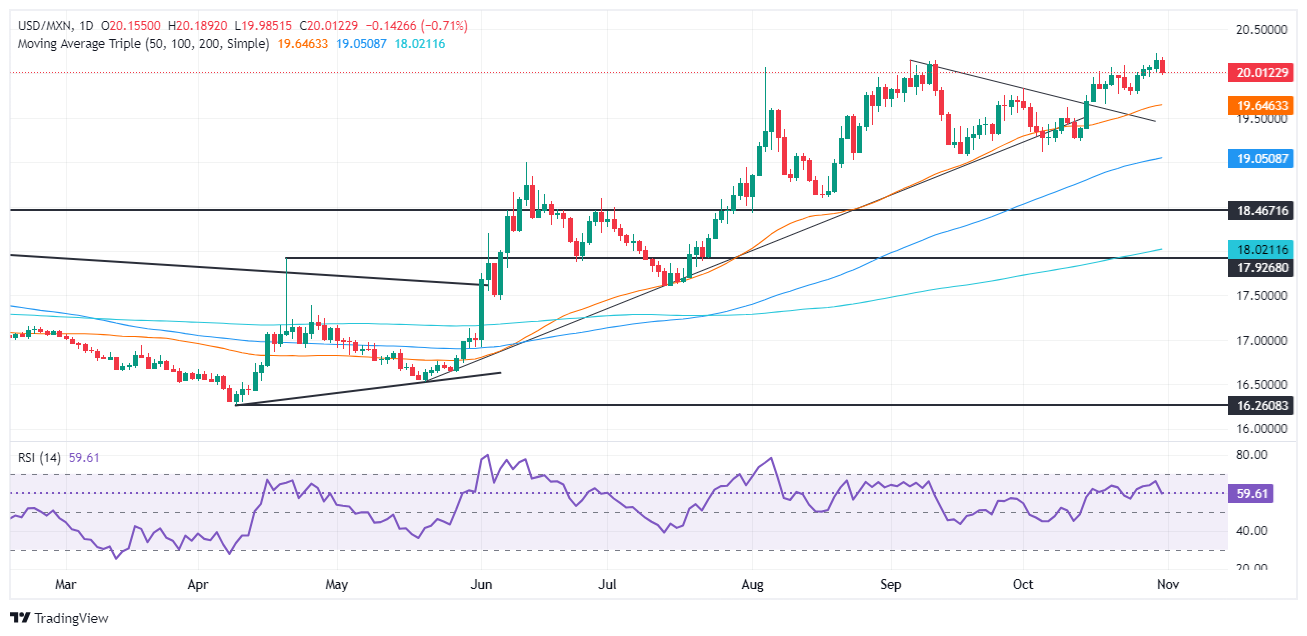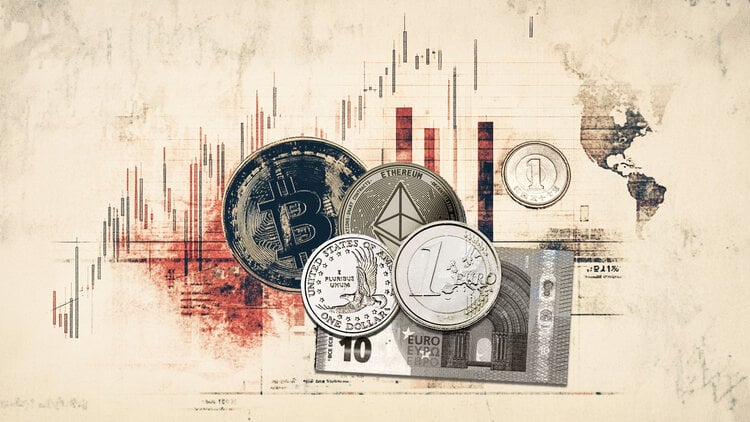- The Mexican Peso appreciates after third quarter GDP growth of 1% quarter-on-quarter, exceeding expectations.
- The Peso remains vulnerable to the results of the US election, as Trump’s threats of tariffs on Mexican car imports weigh on sentiment.
- Upcoming data from Mexico on business confidence and employment, along with Non-Farm Payrolls and the US ISM Manufacturing PMI, could influence the USD/MXN.
The Mexican Peso appreciated more than 0.60% against the US Dollar on Thursday after posting losses for the fourth consecutive day. The optimistic Gross Domestic Product (GDP) figures revealed in Mexico surpassed the positive data from the United States (US), which failed to boost the Dollar. USD/MXN is trading at 20.01 after hitting a daily high of 20.18.
Mexico’s economy in the third quarter of 2024 grew 1% quarter-on-quarter, above the consensus of 0.8%, revealed the National Institute of Statistics, Geography and Informatics (INEGI). Meanwhile, annual GDP expanded 1.5%, above estimates of 1.2%, but fell short of the second quarter’s 2.1% growth.
Despite posting solid gains, the Mexican currency will remain pressured by the outcome of the US presidential election. Former President Donald Trump’s victory in the November 5 election could weigh on the Peso following his comments that he would impose tariffs 200% to cars manufactured in Mexico.
Joaquín Monfort, an analyst at FX Street, mentioned, “The electoral model on the polling website FiveThirtyEight gives Trump a 52% chance of winning compared to 48% for Vice President Kamala Harris.” However, Monfort added that the latest opinion polls favor Harris, who leads with 48.1% compared to former President Donald Trump’s 46.7%.
Across the border, US data revealed that headline inflation declined, according to the Bureau of Economic Analysis (BEA). However, the core Personal Consumption Expenditure (PCE) Price Index, the Fed’s preferred inflation gauge, was unchanged in October compared to September data.
Other data showed that the number of Americans filing for unemployment benefits in the week ending Oct. 26 fell to its lowest level in five months.
Looking ahead to the week, Mexico’s economic calendar will include business confidence numbers, employment data and the S&P Global manufacturing PMI for October. On the US front, traders are keeping an eye on October Non-Farm Payrolls and the Institute for Supply Management (ISM) Manufacturing PMI.
Daily Market Summary: Mexican Peso Rises After Strong GDP Figures
- The USD/MXN continues to drift due to political turmoil in Mexico following the approval of the controversial judicial reform. Eight of the eleven judges of the Supreme Court announced their resignation effective in August 2025.
- Money market futures suggest that the Bank of Mexico (Banxico) is expected to cut rates between 175 and 200 basis points over the next 12 months.
- The US headline PCE fell from 2.3% to 2.1% year-on-year, moving closer to the Fed’s 2% target. However, excluding volatile elements, the so-called core PCE remained unchanged at 2, 7% year-on-year, exceeding forecasts of 2.6%.
- Initial US jobless claims for the week ending October 26 fell from 228,000 to 216,000, below expectations of 230,000.
- ADP’s national employment change in October increased by 233,000, above estimates of 115,000 and 159,000 in September.
- Data from the Chicago Board of Trade, via the December federal funds rate futures contract, shows that investors are estimating a 49 basis point cut by the Fed by the end of the year.
USD/MXN Technical Outlook: Mexican Peso Recovers as USD/MXN Targets 20.00
The USD/MXN bullish trend continues, although sellers have intervened ahead of the upcoming US election week. Despite this, unless they break above the psychological figure of 20.00, buyers could remain hopeful of higher prices. .
If USD/MXN falls below 20.00, the next support would be the October 24 daily low of 19.74, followed by the 50-day SMA at 19.62.
Otherwise, if USD/MXN holds above 20.00, the next resistance would be the year-to-date (YTD) high of 20.22. Once broken, next would be the psychological level of 20.50, the September 28, 2022 high at 20.57 and the August 2, 2022 peak at 20.82. Once surpassed, the next stop would be the March 8, 2022 high at 21.46.
The oscillators indicate that the buyers are gaining strength, as shown by the Relative Strength Index (RSI) above its neutral line, surpassing the previous highs reached on September 10 and August 22.
The Mexican Peso FAQs
The Mexican Peso (MXN) is the most traded currency among its Latin American peers. Its value is largely determined by the performance of the Mexican economy, the policy of the country’s central bank, the amount of foreign investment in the country and even the levels of remittances sent by Mexicans living abroad, particularly in the United States. . Geopolitical trends can also affect the MXN: for example, the nearshoring process (or the decision by some companies to relocate manufacturing capacity and supply chains closer to their home countries) is also seen as a catalyst for the currency. Mexican, as the country is considered a key manufacturing center on the American continent. Another catalyst for the MXN is oil prices, as Mexico is a key exporter of the raw material.
The main objective of Mexico’s central bank, also known as Banxico, is to keep inflation at low and stable levels (at or near its target of 3%, the midpoint of a tolerance band between 2% and 4%. %). To do this, the bank establishes an appropriate level of interest rates. When inflation is too high, Banxico will try to control it by raising interest rates, which makes borrowing more expensive for households and businesses, thus cooling demand and the economy in general. Higher interest rates are generally positive for the Mexican Peso (MXN) as they lead to higher yields, making the country a more attractive place for investors. On the contrary, lower interest rates tend to weaken the MXN.
The publication of macroeconomic data is key to evaluating the state of the economy and can have an impact on the valuation of the Mexican peso (MXN). A strong Mexican economy, based on high economic growth, low unemployment and high confidence is good for the MXN. Not only does it attract more foreign investment, but it may encourage the Bank of Mexico (Banxico) to raise interest rates, particularly if this strength is accompanied by high inflation. However, if economic data is weak, the MXN is likely to depreciate.
As an emerging market currency, the Mexican Peso (MXN) tends to rise during periods of risk, or when investors perceive overall market risks to be low and are therefore eager to engage in investments that carry higher risk. . Conversely, the MXN tends to weaken in times of market turbulence or economic uncertainty, as investors tend to sell riskier assets and flee to more stable safe havens.
Source: Fx Street
I am Joshua Winder, a senior-level journalist and editor at World Stock Market. I specialize in covering news related to the stock market and economic trends. With more than 8 years of experience in this field, I have become an expert in financial reporting.








